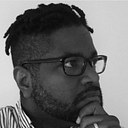Trials of an Open Source Designer
A (long) look back at my 1st year at IBM (Originally written in 2018)
When I arrived at the design studio in San Francisco for orientation, I was ready to get down to business. I was one of the first designers there that morning, which was partly due to the fact that back in Indiana it was already 11am and I was on EST time, and partly because I was more than ready to get started as a full-time designer. Judging from the faces of the other new hires — mostly user experience designers like myself, a few visual designers, and a lone researcher; we’d all brought our A-game from whatever part of the country we’d left or would leave to join the IBM.
During the first few minutes we made our introductions, asked each other if we knew what product or team we had been assigned to, and what studio would be our new home. Only two of us were heading to RTP (Research Triangle Park, NC) — myself and a UX/UI designer who was an awesome artist/illustrator. We both had some inkling of what team we were joining, but neither of us knew anything about the products we would work on. A few days (and a few dozen packs of post-its, markers, and presentations) later, after we’d shared our fears and hopes about what this new journey at IBM would teach us and what we would in-turn teach others, and as quickly as we’d met we parted ways.
The first few weeks on the team were great! I met all the designers (ux, visual, research, and FEDs) at the RTP design studio, got an overview of the product history for the WebSphere and App Platform team, and learned about the Cary, Durham, and Raleigh beef (it’s real…where you live is everything out here). I was also given my first projects: two site redesigns and an internal tool for new designers to learn about the full suite of IBM products. Based on my graduate experience, two design internships, and after working as a technical writer and software support agent for 4 years at a software company, I had a picture in my mind of what life as a designer would be like. But — what I was about to embark on was very, very…different. Designing for Open Source.
After dozens of notebook filling conversations with SMEs (subject matter experts), two site audits, a few design playbacks and several rounds of customer interviews, I was ready to roll. I made countless design artifacts, socialized wireframes, and called out opportunities for product improvements — long story short, I had done the work and was ready to change both products — and by extension, the world (okay, maybe not the world). But what I quickly discovered was that designing open source is about flexibility — both in engaging with developers and the larger community. Long story short, I learned that with open source products, designers have to share the ownership of that experience with the open source community and the developers that are willing to help code voluntarily.
On of the first steps I took was to get more integrated into dev workflows by communicating on their home turf, using tools like GitHub to not only track and monitor items assigned to the product roadmap. I also used GitHub as a place to solicit feedback on designs, track design changes, discuss implementation specs, and identify partners to assist with content re-design work (for micro-copy, headers, and information architecture direction). It was slow going at first, but eventually, things moved more quickly in spurts here and there. But there was still a lot of push back from devs. I’d iterate on a feature or flow, improve it through critique sessions, then schedule a playback — but dev resources blocked design implementation so I was often at the mercy of who was available and willing to code changes to the site. It was a tough, sobering experience. Still, no matter what obstacles I encountered my team was there to encourage me and help me frame everything I was learning in the process. I learned so much during my first year at IBM, but the most important lesson was the importance of having a great team!
Here my big takeaway for all the designers that are just beginning the journey. When you don’t know what your doing, make sure the right people are right there — giving feedback, perspective, encouragement and awkward dancing if necessary!
Bonus:
One of the thing that I believe makes a good writer, thinker, creative — GREAT is reading. So here are a few books that I’m working through right now.
- A Promise Land: Barack Obama
- The Water Dancer: Ta-Nehisi Cotes
- Lovecraft Country: Max Ruff
